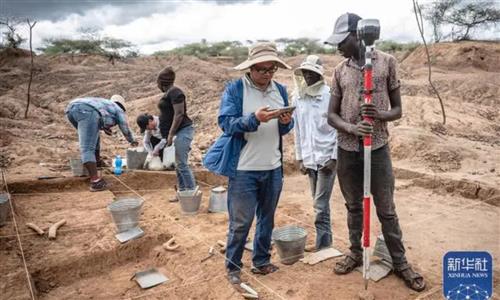ARTS / CULTURE & LEISURE
First evidence of Paleolithic stone-tool kiln in East Asia revealed in N.China

Nihewan Basin in North China's Hebei Province Photo: Courtesy of the National Cultural Heritage Administration
Chinese archaeologists have made new discoveries at the ancient sites in Nihewan Basin, North China's Hebei Province, revealing East Asia's first-ever evidence of the "heat-treated stone-tool" kiln dating back from 18,000 to 15,000 years ago, or the Paleolithic period, reported Hebei Daily on Monday.
Wang Fagang, a researcher at the Hebei Provincial Institute of Cultural Relics and Archaeology, told the Global Times on Monday that this marks a significant advancement in the application of natural science in stone toolmaking, pointing to a leap in human technological progress.
The kiln discovered at the No.5 pit of the Xinmiaozhuang site is an oval-shaped structure, approximately one meter in size, built from several gravel stones.
Inside, they found ash and burnt clay, suggesting that the stones were heated to alter the volcanic gravel's properties, making it easier to detach thin stone flakes. This is the first discovery of its kind in North China from the Paleolithic period.
"Traditionally, we believed stone tool making was simply a matter of subtraction, changing the shape of the material," Wang said. "Heat treatment, however, alters the internal structure of the stone itself."
The site's significance extends beyond No.5 pit excavations. The Xinmiaozhuang site has uncovered remains from six distinct periods, ranging from 120,000 to 15,000 years ago, boasting a rich cultural stratigraphy and well-defined layering sequence, revealing six distinct phases of human activity.
In addition to the kiln, over 100 decorative items, including ostrich eggshells and leather beads, were discovered at the site, making it the richest site for such artifacts in the North China Paleolithic context.
With over 70,000 stone artifacts discovered, the site, located across the Hutuoliang site from the Upper Paleolithic to the Neolithic transitional zone, shows evidence of consistent stone tool making techniques, offering valuable insights into ancient humans' methods of stone sourcing, processing, and transport. It further offers extraordinary value for the exploration of the mode of origin of modern humans in East Asia.
"In 1986, we discovered 5,000 scraper tools and abundant animal fossils at the No.1 pit, dating back 75,000 to 63,000 years, which exhibit a strong Mousterian style - a hallmark of the Middle Paleolithic in Europe," Wang noted. "Whether this represents an evolution of indigenous Chinese technologies or evidence of East-West cultural exchange remains an open question."
At Site No.2, over 14,000 items, including distinctive flake tools, animal fossils, and hematite, were uncovered, dating back to 45,000-42,000 years ago. This marks the first discovery of flake technology in North China, filling a crucial gap in the region's Paleolithic record and providing key evidence for exploring the origins of modern humans in the area.
Evidence of microlithic tool making technique dating back 27,000 to 26,000 years was also revealed at the No.4 pit, which provides further insight into the development of tool-making techniques, bridging the gap between flake and microlithic techniques. These findings construct a cultural timeline of human evolution in the region since the Late Pleistocene.
"Besides the stone tools, the artifacts, which include bones with traces of fire use, burned stones, and decorative items, come from a critical period in the dispersal of early modern humans, and offer essential clues for understanding the symbolic behavior and diverse expressions of early humans in northern China," Wang said.



